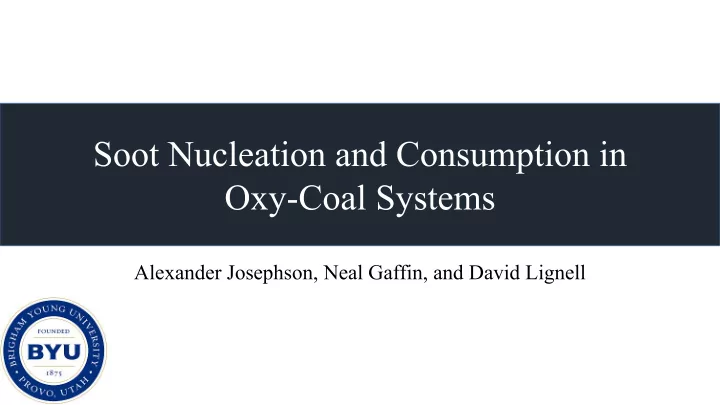

Soot Nucleation and Consumption in Oxy-Coal Systems Alexander Josephson, Neal Gaffin, and David Lignell
Acknowledgements • This material is based upon work supported by the Department of Energy, National Nuclear Security Administration, under Award Number(s) DE- NA0002375 • Support is acknowledged from the University of Utah, and Brigham Young University • This work is part of a larger work performed by the CCMSC, a tri-university center with oversight and collaboration with three national labs.
Oxy-Coal Combustion • Due to the increasing concern of impending CO 2 regulations, research into various carbon capture technologies has increased. • Oxy-fuel combustion allows for easy separation of CO 2 . • For the foreseeable future we are, both national and internationally, still largely dependent on coal for energy. • Coal presents unique challenges: Complex fuel § Chemical structure § Dynamic morphology throughout combustion § Multi-phase flows § Diverse reaction rates §
Soot • Soot is a carbonaceous particle formed in flames’ fuel-rich areas. • Highly influences radiative heat transfer to boiler walls. (If available include Ben’s studies here.) • Can act as a nitrogen sink. • If not fully consumed, can pose significant health risks.
Coal-derived Soot Soot Formation (Gaseous Fuel) Soot Formation (Solid Fuel) Soot particles primary source are PAH (polycyclic aromatic • hydrocarbons) that are formed in the fuel-rich region of the flame. Creation and growth of PAHs to a critical size is the limiting • step in soot formation Soot particles primary source are tars, that are released • from the coal particle during devolatilization. Tends to have higher sooting potential than gaseous fuels. •
Nucleation Tar Molecule • In traditional soot models, PAH is the building block of soot nucleation o PAH molecules form and grow through various mechanisms to form soot particles • Coal systems contain tars, which are essentially PAH molecules with a few differences: o Elemental analysis of tar reveals composition similar to parent coal Common PAH Molecules o Molecule is made up of aromatic clusters with potentially large amounts of aliphatic side chains o Average tar molecular weight: ~350 amu • In coal-derived soot models, tar is the building block of soot nucleation • Complete model must include the evolution of tars in a system along
Tar Cracking • Tar molecules have a tendency to undergo a secondary pyrolysis and shed its aliphatic parts • Atoms in rings tend not be removed as easily, nitrogen of particular importance • Results in aromatic clusters very similar to the more common PAHs • It is possible that not all aliphatic portions are consumed • Cracking happens in parallel with surface growth but tends to happen at a much faster rate
Tar NMR Parameters
Hydrogen Abstraction and Carbon Addition Surface Growth via Acetylene Addition Surface Growth via PAH Condensation • Starting benzene ring is radicalized usually by reaction with • Starting benzene ring is radicalized similarly. • the hydrogen radical. Mechanism is dependent on mostly on concentrations of the • Mechanism is dependent on mostly on concentrations of the H radical, acetylene, and PAH. H radical and acetylene. • PAH can vary in size as long as the geometry of the molecule • Propagation reaction. permits the site reactions. • Propagation reaction.
Nucleation Model Model will transport two internal coordinates: • Aliphatic tar mass, with two source terms: • Production of mass based off tar product from devolatilization: • For its consumption based off secondary pyrolysis: • PAH the following source terms: • Production of mass based off tar product from devolatilization: • Surface growth of aromatics: • Dr. Frenklach’s growth by HACA • PAH condensation: • Growth again by HACA • PAH to soot particles: • Assume a log-normal distribution of tar and a certain % of tar becomes soot based off of 2000 amu. •
Consumption Oxidation Gasification Dominates traditional combustion Negligible in traditional combustion • • Occurs by the attack of oxidizing agents Occurs by the attack of high energy • • molecules • O 2 , OH - , O - , etc • Products are oxidized carbon species • CO 2 , H 2 O, etc Products are fractured species • • CO 2 , CO, etc • H 2 , CH, CO, etc Strongest at the high temperature and • Occurs at the particle surface but • fuel-lean areas reactions can penetrate deeper Occurs at on the particle surface • Rates dependent on temperature and • species concentrations.
Oxidation This is a modified Arrhenius model with the • temperature dependence decoupled from the Arrhenius constant and reaction orders determined through numerical experimentation Couples oxidation by the O - radical with • oxidation by OH or O 2 Activation energy for the OH is considered • significantly small to be negligible Tunable parameters are the two Arrhenius • constants and the one activation energy
Gasification Modified Arrhenius model with temperature • dependence decoupled from Arrhenius constant Reaction orders determined through numerical • experimentation CO 2 Data Fit • Experimentation was done for CO 2 and H 2 O independently so analysis for different terms could be done separately Tunable parameters are the two Arrhenius • constants, two activation energies, and the H 2 O reaction order H 2 O Data Fit
Model Calibration Bayes’ Theorem - ‘Prior’, incorporates prior knowledge into a pdf - Data uncertainty - ‘Likelihood’, taken from a Gaussian pdf -‘Posterior’, resultant pdf for parameter estimation
Conclusion
Recommend
More recommend